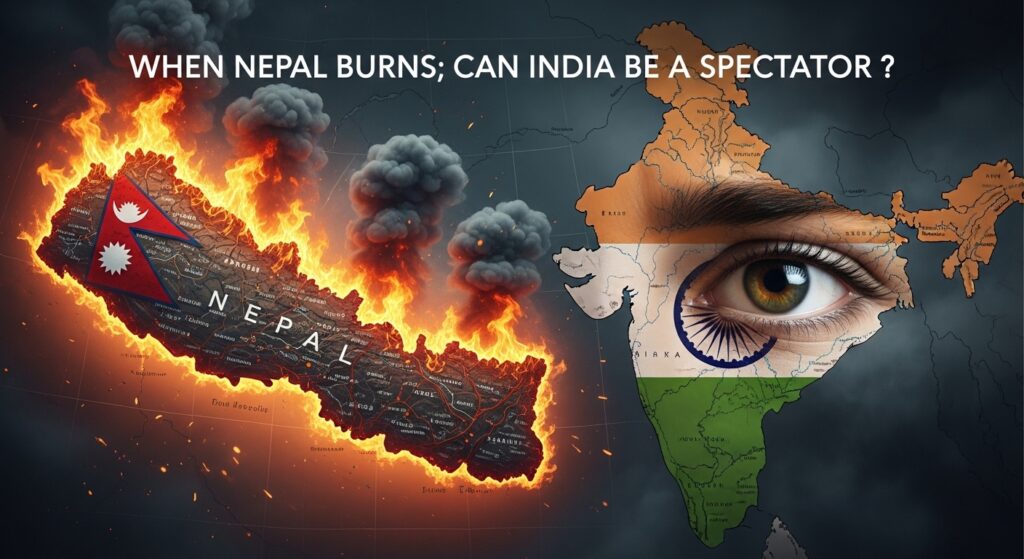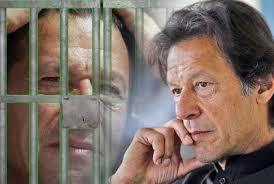Kathmandu burns. Delhi sweats. As Nepal’s Gen-Z rebels storm parliament and 13,000 prisoners escape into chaos, India watches its crucial buffer state collapse in real-time. The flames aren’t just consuming Nepal; they’re exposing India’s strategic nakedness.

The smoke from Kathmandu’s burning parliament isn’t just choking Nepal’s streets, it’s reaching deep into India’s strategic corridors, raising uncomfortable questions about regional stability and New Delhi’s diminishing influence over its northern neighbour. As Gen Z-led protests topple prime ministers and create the deadliest social unrest Nepal has seen in decades, India finds itself caught between diplomatic restraint and growing anxiety about its vulnerable northern flank.
The protests have already sent tremors across the India-Nepal border. Heightened security measures at the border are slowing the movement of goods, affecting supplies of medicines, petroleum products, agricultural commodities, and industrial machinery. Paramilitary and police units patrolled Panitanki in West Bengal’s Darjeeling district, where the unrest led to partial disruption of trade and left several trucks stranded.
This isn’t merely an economic inconvenience; it’s a preview of what could unfold if Nepal spirals further into chaos. Since near 70% of Nepal’s imports reportedly enter the country through Birgunj, closure of border crossings leads to widespread disruption that has drastic impact on daily life in most of the country. The 2015 blockade demonstrated how quickly economic warfare can escalate into diplomatic disaster.
The Buffer State That’s Slipping Away
Nepal’s strategic importance as a buffer between India and China cannot be overstated. For India, “Nepal holds special significance because it is a ‘buffer state’ between India and China.” But this buffer is increasingly unreliable. Nepal has one of the world’s youngest populations and, especially after India’s implicit support for the 2015 blockade on the landlocked country, anti-Indian sentiments have been running high.
The current uprising differs dramatically from previous political upheavals. Unlike the Madhesi movement that had clear pro-India undertones, this Gen-Z rebellion shows no particular affinity toward New Delhi. The protesters’ anger is directed at systemic corruption and governance failures, issues that resonate across South Asia and could easily spillover.
The Geopolitical Red Flags
1. The Third Domino Falls
From Nepal’s social media ban riots to Bangladesh’s student uprising and Sri Lanka’s economic collapse, India’s neighbours face repeated upheavals with regional fallout. This pattern is alarming, three of India’s immediate neighbours have witnessed mass uprisings within three years, each following a similar trajectory of youth-led protests against entrenched elites.
2. China’s Opportunistic Opening
Every moment of instability in Nepal presents Beijing with an opening to expand its influence. The current crisis could push any new Nepali leadership to diversify their partnerships away from India’s traditional dominance. China has been patient and strategic in building relationships across Nepal’s political spectrum.
3. The Youth Factor
As expert Vijayakant Karna observes in the document: “People lack employment, jobs are scarce. Farmers aren’t getting fertilizers, water for irrigation isn’t available. There’s no rule of law in the country.” This isn’t unique to Nepal, similar conditions exist across South Asia, making the protests potentially contagious.
Indian experts remain cautious about the crisis’s potential spillover effects, though this optimism may be misplaced. The underlying governance failures that triggered Nepal’s uprising exist throughout the region, creating similar vulnerabilities across South Asia.
If Nepal’s political collapse deepens, India faces multiple challenging scenarios. A massive refugee influx across the porous 1,751-kilometer border would be nearly impossible to control. Political instability often creates spaces for non-state actors, and a weakened Nepal could become a haven for elements hostile to India, particularly given the easy border crossings. Most concerning is the contagion effect, youth across South Asia face similar challenges of unemployment, corruption, and blocked opportunities, and Nepal’s success in toppling a government could inspire similar movements elsewhere.
What India Must Do (But Probably Won’t)
India’s traditional playbook of backing stable strongmen and maintaining the status quo is failing across the region. The new reality demands:
Immediate Actions:
- Strengthen border security without appearing heavy-handed
- Prepare contingency plans for refugee flows
- Engage with Nepal’s emerging youth leadership
Long-term Strategy:
- Move beyond transactional relationships to genuine partnership
- Address the root causes that fuel regional instability
- Develop soft power initiatives targeting South Asian youth
The Uncomfortable Truth
India’s biggest mistake would be treating Nepal’s crisis as an isolated event. The unrest in Nepal reportedly impacted activities along the India-Nepal border, with markets falling silent, causing larger economic stagnation across neighbouring regions. This is just the beginning.
The harsh reality is that India’s neighbourhood is becoming increasingly unstable, and New Delhi’s traditional tools of influence are proving inadequate. Nepal’s burning streets aren’t just a local tragedy; they’re a warning signal that the entire South Asian order is fracturing.
As one parliament building burns in Kathmandu, India must ask itself: are we watching Nepal’s crisis, or previewing our own future challenges? The answer may determine whether India emerges as a stabilizing regional power or becomes another casualty of the South Asian Spring.
The flames in Nepal aren’t just lighting up Kathmandu’s night sky, they’re illuminating the vulnerabilities in India’s own strategic architecture.



This is a very relevant and timely piece Dr. Ashish Ji — Nepal’s unrest should serve as a wake-up call for India. The fault lines are visible here too: the prolonged mishandling of Manipur, rising discontent in the South over language and resource issues, youth unemployment and lack of opportunities in UP and Bihar, as well as recurring tensions in J&K and Bengal. Add to this the growing perception of governance gaps and unequal development, and the risks become even more alarming. Recent events like total biased and one sided press conferences by CEC has increased the discontent.
Unless these are addressed with urgency, inclusion, and accountability, India may not be far behind in facing the same instability we see in Nepal today.
Thank you sir !